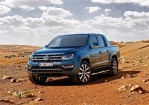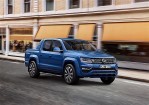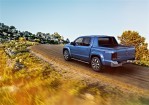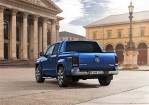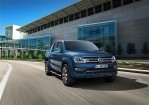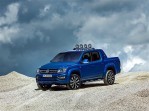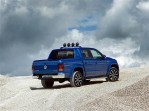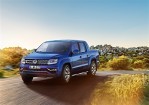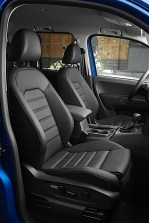Body style: Truck
Segment: Midsize Pickup
Production years: 2016, 2017, 2018, 2019, 2020
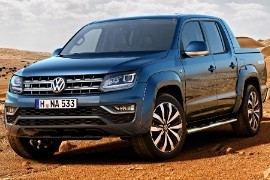 58 Photos
58 PhotosWhen Volkswagen introduced the Amarok in 2010, it didn't know too much about this segment, but most of the model's problems were solved in 2016 when the carmaker introduced a facelift for this pickup.
Thus, the idea of a lifestyle pickup started to emerge on the market. Apart from a few Japanese brands, Volkswagen Commercial Vehicle developed the Amarok, which was exactly that: a pickup that was better at transporting light loads and five people than heavy loads and just two.
Volkswagen refreshed the Amarok in 2016 and made it look more like an SUV than a utility vehicle. Thus, the front fascia received a new pair of headlights with integrated LED daytime running lights. The grille was also revised and now resembled the ones fitted on the likes of Tiguan and Touareg. Its profile still kept the same flared, angular wheel arches. As an option, the automaker offered side steps and a roll-bar in the bed area.
Inside, there was more of an SUV feel than a utility vehicle. The dashboard was covered with softer materials and sported a new infotainment system atop the center stack. Moreover, the instrument cluster featured large dials and a TFT display between the tachometer and speedometer that showed various data from the onboard computer. Depending on the options, the Amarok could have been fitted with fabric or leather upholstery.
But the most significant change was under the hood, where Volkswagen installed a 3.0-liter turbo-diesel V6 engine, which was available with a few power options. Another unusual decision was for the transmission. While the manual versions were fitted with a high and low transfer case, the eight-speed automatic was an all-wheel drive affair with no reduction gear.
VOLKSWAGEN Amarok Double Cab 2016, 2017, 2018, 2019, 2020
- 3.0L V6 4MOTION 6MT AWD (163 HP)
- 3.0L V6 4MOTION 8AT AWD (258 HP)
- 3.0L V6 6MT (163 HP)
- 3.0L V6 TDI 4MOTION 8AT (204 HP)
- 3.0L V6 TDI 4MOTION 8AT (224 HP)
VOLKSWAGEN Amarok Double Cab
3.0L V6 4MOTION 6MT AWD (163 HP)
ENGINE SPECS - 3.0L V6 4MOTION 6MT AWD (163 HP) | |
|---|---|
| Cylinders: | V6 |
| Displacement: | 2967 cm3 |
| Power: | 119.9 KW @ 2750-4500 RPM 163 HP @ 2750-4500 RPM 161 BHP @ 2750-4500 RPM |
| Torque: | 332 lb-ft @ 1250-2500 RPM 450 Nm @ 1250-2500 RPM |
| Fuel System: | Turbocharged Common Rail |
| Fuel: | Diesel |
| Fuel capacity: | 21.1 gallons (79.9 L) |
PERFORMANCE SPECS | |
|---|---|
| Top Speed: | 112 mph (180 km/h) |
| Acceleration 0-62 Mph (0-100 kph): | 9.6 s |
TRANSMISSION SPECS | |
|---|---|
| Drive Type: | All Wheel Drive |
| Gearbox: | 6-speed manual |
BRAKES SPECS | |
|---|---|
| Front: | Ventilated Discs |
| Rear: | Discs |
TIRES SPECS | |
|---|---|
| Tire Size: | 245/65 R17 |
DIMENSIONS | |
|---|---|
| Length: | 204.4 in (5192 mm) |
| Width: | 61.2 in (1554 mm) |
| Height: | 73.9 in (1877 mm) |
| Wheelbase: | 121.7 in (3091 mm) |
| Ground Clearance: | 7.6 in (193 mm) |
WEIGHT SPECS | |
|---|---|
| Unladen Weight: | 4469 lbs (2027 kg) |
| Gross Weight Limit: | 6437 lbs (2920 kg) |
FUEL ECONOMY (NEDC) | |
|---|---|
| City: | 23.3 mpg US (10.1 L/100Km) |
| Highway: | 32.2 mpg US (7.3 L/100Km) |
| Combined: | 28.3 mpg US (8.3 L/100Km) |
| CO2 Emissions: | 219 g/km |
VOLKSWAGEN Amarok Double Cab
3.0L V6 4MOTION 8AT AWD (258 HP)
ENGINE SPECS - 3.0L V6 4MOTION 8AT AWD (258 HP) | |
|---|---|
| Cylinders: | V6 |
| Displacement: | 2970 cm3 |
| Power: | 189.8 KW @ 3250-4000 RPM 258 HP @ 3250-4000 RPM 255 BHP @ 3250-4000 RPM |
| Torque: | 428 lb-ft @ 1400-3000 RPM 580 Nm @ 1400-3000 RPM |
| Fuel System: | Turbocharged Common Rail |
| Fuel: | Diesel |
| Fuel capacity: | 21.1 gallons (79.9 L) |
PERFORMANCE SPECS | |
|---|---|
| Top Speed: | 129 mph (208 km/h) |
| Acceleration 0-62 Mph (0-100 kph): | 7.4 s |
TRANSMISSION SPECS | |
|---|---|
| Drive Type: | All Wheel Drive |
| Gearbox: | 8-speed automatic |
BRAKES SPECS | |
|---|---|
| Front: | Ventilated Discs |
| Rear: | Discs |
TIRES SPECS | |
|---|---|
| Tire Size: | 245/65 R17 |
DIMENSIONS | |
|---|---|
| Length: | 204.4 in (5192 mm) |
| Width: | 61.2 in (1554 mm) |
| Height: | 73.9 in (1877 mm) |
| Wheelbase: | 121.7 in (3091 mm) |
| Ground Clearance: | 7.6 in (193 mm) |
WEIGHT SPECS | |
|---|---|
| Unladen Weight: | 4806 - 4982 lbs (2180 - 2260 kg) |
| Gross Weight Limit: | 6437 lbs (2920 kg) |
FUEL ECONOMY (NEDC) | |
|---|---|
| Combined: | 23.5 mpg US (10 L/100Km) |
| CO2 Emissions: | 208 g/km |
VOLKSWAGEN Amarok Double Cab
3.0L V6 6MT (163 HP)
ENGINE SPECS - 3.0L V6 6MT (163 HP) | |
|---|---|
| Cylinders: | V6 |
| Displacement: | 2967 cm3 |
| Power: | 119.9 KW @ 2750-4500 RPM 163 HP @ 2750-4500 RPM 161 BHP @ 2750-4500 RPM |
| Torque: | 332 lb-ft @ 1250-2500 RPM 450 Nm @ 1250-2500 RPM |
| Fuel System: | Turbocharged Common Rail |
| Fuel: | Diesel |
| Fuel capacity: | 21.1 gallons (79.9 L) |
PERFORMANCE SPECS | |
|---|---|
| Top Speed: | 112 mph (180 km/h) |
| Acceleration 0-62 Mph (0-100 kph): | 9.6 s |
TRANSMISSION SPECS | |
|---|---|
| Drive Type: | Rear Wheel Drive |
| Gearbox: | 6-speed manual |
BRAKES SPECS | |
|---|---|
| Front: | Ventilated Discs |
| Rear: | Discs |
TIRES SPECS | |
|---|---|
| Tire Size: | 245/65 R17 |
DIMENSIONS | |
|---|---|
| Length: | 204.4 in (5192 mm) |
| Width: | 61.2 in (1554 mm) |
| Height: | 73.9 in (1877 mm) |
| Wheelbase: | 121.7 in (3091 mm) |
| Ground Clearance: | 7.6 in (193 mm) |
WEIGHT SPECS | |
|---|---|
| Unladen Weight: | 4297 lbs (1949 kg) |
| Gross Weight Limit: | 6393 lbs (2900 kg) |
FUEL ECONOMY (NEDC) | |
|---|---|
| City: | 23.5 mpg US (10 L/100Km) |
| Highway: | 33.6 mpg US (7 L/100Km) |
| Combined: | 29 mpg US (8.1 L/100Km) |
| CO2 Emissions: | 213 g/km |
VOLKSWAGEN Amarok Double Cab
3.0L V6 TDI 4MOTION 8AT (204 HP)
ENGINE SPECS - 3.0L V6 TDI 4MOTION 8AT (204 HP) | |
|---|---|
| Cylinders: | V6 |
| Displacement: | 2967 cm3 |
| Power: | 150 KW @ 3000-4500 RPM 204 HP @ 3000-4500 RPM 201 BHP @ 3000-4500 RPM |
| Torque: | 369 lb-ft @ 1250-2750 RPM 500 Nm @ 1250-2750 RPM |
| Fuel System: | Turbocharged Common Rail |
| Fuel: | Diesel |
| Fuel capacity: | 21.1 gallons (79.9 L) |
PERFORMANCE SPECS | |
|---|---|
| Top Speed: | 116 mph (187 km/h) |
| Acceleration 0-62 Mph (0-100 kph): | 9.1 s |
TRANSMISSION SPECS | |
|---|---|
| Drive Type: | All Wheel Drive |
| Gearbox: | 8-speed automatic |
BRAKES SPECS | |
|---|---|
| Front: | Ventilated Discs |
| Rear: | Discs |
TIRES SPECS | |
|---|---|
| Tire Size: | 245/65 R17 |
DIMENSIONS | |
|---|---|
| Length: | 204.4 in (5192 mm) |
| Width: | 61.2 in (1554 mm) |
| Height: | 73.9 in (1877 mm) |
| Wheelbase: | 121.7 in (3091 mm) |
| Ground Clearance: | 7.6 in (193 mm) |
WEIGHT SPECS | |
|---|---|
| Unladen Weight: | 4526 lbs (2053 kg) |
| Gross Weight Limit: | 6437 lbs (2920 kg) |
FUEL ECONOMY (NEDC) | |
|---|---|
| City: | 27.4 mpg US (8.6 L/100Km) |
| Highway: | 32.2 mpg US (7.3 L/100Km) |
| Combined: | 30.2 mpg US (7.8 L/100Km) |
| CO2 Emissions: | 203 g/km |
| Notes |
|---|
| AdBlue tank: 13L |
VOLKSWAGEN Amarok Double Cab
3.0L V6 TDI 4MOTION 8AT (224 HP)
ENGINE SPECS - 3.0L V6 TDI 4MOTION 8AT (224 HP) | |
|---|---|
| Cylinders: | V6 |
| Displacement: | 2967 cm3 |
| Power: | 164.7 KW @ 3000-4500 RPM 224 HP @ 3000-4500 RPM 221 BHP @ 3000-4500 RPM |
| Torque: | 406 lb-ft @ 1400-2750 RPM 550 Nm @ 1400-2750 RPM |
| Fuel System: | Turbocharged Common Rail |
| Fuel: | Diesel |
| Fuel capacity: | 21.1 gallons (79.9 L) |
PERFORMANCE SPECS | |
|---|---|
| Top Speed: | 120 mph (193 km/h) |
| Acceleration 0-62 Mph (0-100 kph): | 8 s |
TRANSMISSION SPECS | |
|---|---|
| Drive Type: | All Wheel Drive |
| Gearbox: | 8-speed automatic |
BRAKES SPECS | |
|---|---|
| Front: | Ventilated Discs |
| Rear: | Discs |
TIRES SPECS | |
|---|---|
| Tire Size: | 245/65 R17 |
DIMENSIONS | |
|---|---|
| Length: | 204.4 in (5192 mm) |
| Width: | 61.2 in (1554 mm) |
| Height: | 73.9 in (1877 mm) |
| Wheelbase: | 121.7 in (3091 mm) |
| Ground Clearance: | 7.6 in (193 mm) |
WEIGHT SPECS | |
|---|---|
| Unladen Weight: | 4941 lbs (2241 kg) |
| Gross Weight Limit: | 6437 lbs (2920 kg) |
FUEL ECONOMY (NEDC) | |
|---|---|
| City: | 27.4 mpg US (8.6 L/100Km) |
| Highway: | 32.2 mpg US (7.3 L/100Km) |
| Combined: | 30.2 mpg US (7.8 L/100Km) |
| CO2 Emissions: | 204 g/km |







